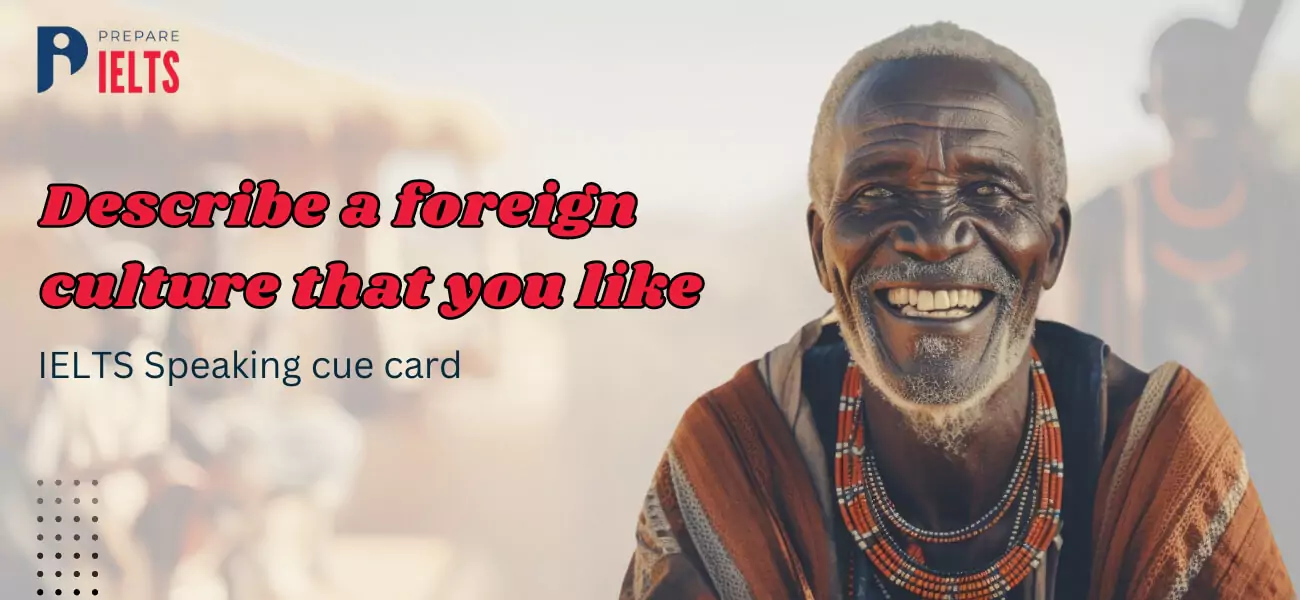
Overview
Welcome, IELTS students! The ability to effectively articulate your thoughts is quite important in the IELTS speaking section. “Talk about a Traditional Object of your Country”, is one of the common subjects featured on the cue cards.
Today, in this blog, we will go over how to create extensive and structured responses to topics such as regarding an article. Navigating this cue card demands a smart approach, and we'll provide you with three extensive sample answers to help you with your IELTS Speaking cue card section practice.
- Overview
- Talk about a Traditional Object of your Country cue card - Sample Answer 1
- Talk about a Traditional Object of your Country cue card - Sample Answer 2
- Talk about a Traditional Object of your Country cue card - Sample Answer 3
- Related IELTS cue card topics
- IELTS Speaking Part 3 - Follow Up Questions
- Conclusion
Talk about a Traditional Object of your Country cue card - Sample Answer 1
Introduction
To live comfortably in the modern era, we rely heavily on items produced by machines in factories and are changed according to the fashions. A few old things, however, have preserved their glitter despite the passage of time. I'd like to talk about a product I believe deserves mentioning.
What is it?
Here, I would like to discuss the traditional bed, “charpai.” In early times, almost every household used to keep it.
How is it made?
Charpai is well-known for its organic quality. To create it, the artisan combines weaving and woodworking talents. A rectangular structure with four legs is created by interlacing different patterns of natural rope. Moonj, a historically grown grass, is the main ingredient in traditional charpai.
When did you first try it?
I tried it for the first time last year when I went to a village with my grandparents. I stayed in my great-grandfather's old house. However, my grandparents’ cousins were already staying there. Because of the large number of visitors staying at his house, I had to sleep outside on that bed. I wasn't sure if I should sleep on it or not at first. Nonetheless, to my astonishment, I slept for eight hours straight.
Why do you like it?
One of the many reasons I like it is that it makes me feel more connected to my roots and culture. Furthermore, because my job requires me to sit for lengthy periods of time, I frequently have back pain or muscle spasms. But every time I sleep on Charpai, my pain subsides, and I wake up with a happy mindset.
Conclusion
Overall, this type of bed has its own value, and people continue to use it as they did earlier.
Talk about a Traditional Object of your Country cue card - Sample Answer 2
Introduction
Traditional things have historical significance and should be conserved; this object demonstrates our culture's relevance. It is our responsibility to pass on our culture to the next generation so that they can understand how people lived in the past. There are several agricultural goods, domestic items, and home decor from the past that were handcrafted and have a great worth.
What is it?
In this article, I will discuss bullock carts, a fascinating traditional object in my country. In the past, bullock carts were employed for local travelling, and the bulk of farmers relied on agriculture and animal husbandry. They travelled to farms and adjacent villages on a Bullock Cart. In ancient times, this cart was also utilised by kings and queens for their daily travel.
How is it made?
It was built of wood and iron, and the entire vehicle was created by local craftsmen with experience in building such vehicles. A lot of work went into making it appear nice. Such vehicles were built with wooden tyres and high-quality steel. This vehicle is constructed by members of the Vishwakarma community.
When did you first try it?
When I was a kid, I used to go to my town and see these vehicles transporting grass and agricultural items to the city. In this cart, my grandfather drove me to the city. It was a thrilling ride for me. I inquired about the vehicle out of curiosity, and I was astounded by such automobiles. My grandfather also told me stories about ancient carts and how they were used.
Why do you like it?
It appealed to me because it depicts true village life. The intricate woodwork on it demonstrates how skilful the carpenters were in old times. And every single component needed to construct these carts was handcrafted. These items greatly impressed me.
Conclusion
All in all, this traditional bullock was a highly useful object, and many people still use it in some places as before.
Register Now, for a free Mock test - Join Today!
Talk about a Traditional Object of your Country cue card - Sample Answer 3
Introduction
India has a diverse and distinct culture has evolved over thousands of years and varies by location.
What is it?
However, one thing you can find in most parts of my country, India, is ‘Sari.’ It is one of the most revered and recognisable traditional objects. Sari is a six to nine-yard piece of fabric that ladies wrap around themselves to represent our culture, grace, and eternal beauty.
How is it made?
The Sari is a stunning piece of apparel with intricate designs and vibrant colours. Typically, it is constructed of silk or cotton. It was mentioned in ancient literature and dates back thousands of years. It's more than just an outfit; it's a symbol of femininity and tradition.
When did you first try it?
The Sari's significance in Indian culture cannot be overstated. It represents our illustrious ancestors and is more than just an item of clothing. Many occasions, including festivals and weddings, require ladies to wear this. It represents modesty and grace. Our rich culture is evident in the various ways it is wrapped in various areas.
Why do you like it?
I have a plethora of memories related to the Sari. Every morning, I would watch my grandmother beautifully drape her Sari. It was a ritual for her, and she would tell me stories about each style's significance and history. The Sari has been a part of my life since I was a youngster, and wearing it connects me to my heritage. I wore a Sari to my high school graduation; it was more than simply an attire; it represented my passage to maturity.
Conclusion
Overall, the Sari is more than just a piece of clothing; it is a part of our identity. It embodies our beliefs, traditions, and the splendour of our culture. It's a timeless emblem that holds a particular place in my heart and the hearts of millions of Indians.
Related IELTS cue card topics
Check the other IELTS cue card topics to practice
1 Describe a Time You Were Very Busy
IELTS Speaking Part 3 - Follow Up Questions
Q: Describe another traditional product produced in your nation (apart from what you spoke about).
A: India is a diverse nation. In India, there are numerous traditional items. We have earthen pots, Jaipur ceramic pottery, Rajasthan puppets, Punjab phulkari needlework, Srinagar hand-knotted carpets, and much more.
Q: What advantages do traditional items offer to locals?
A: In my opinion, traditional products help to identify the people of a location. Locals represent their cities or states everywhere through their traditions, including people's homes. Apart from this, traditional products have a monetary advantage as well. People run thriving companies on traditional products.
Q: Do you believe that the government should promote traditional products?
A: The government should undoubtedly encourage and expand the consumer base for conventional products, which is already taking place. We notice airport brands solely selling traditional products; every railway station has at least one shop selling local traditional artifacts, such as bamboo leaves, palm leaves, embroideries, etc. A number of exhibits are also held in my city, bringing traditional products from all over the country under one roof.
Q: Do you believe countries are adopting each other's traditions due to globalisation?
A: Yes, because of globalisation, different cultures are colliding, and individuals are learning how to live in a global culture. People are exchanging ideals, customs, and rituals with one another. In fact, by doing so, a new global culture is emerging that will be incredibly helpful to the future.
Q: Why do individuals purchase handcrafted or traditionally significant products?
A: Some individuals buy it because of its historical significance. They believe it helps them connect with their roots, culture, or a bygone era. Some individuals, however, buy them because they are handcrafted things. Handmade things are considered more valuable and unique than machine-made items.
Q: Did the customary items of the past have greater worth than those of today?
A: Traditional products from the past are undeniably significant, although their use is significantly less than modern products. Manufacturers modify the design and features of their products to meet changing consumer demands. Antiques, on the other hand, are more valuable than modern products.
Q: Did the quality of traditional items of the past surpass that of contemporary items?
A: Traditional products from the past are undeniably significant, although their use is significantly less than modern products. Manufacturers modify the design and features of their products to meet changing consumer demands. Antiques, on the other hand, are more valuable than modern products.
Q: Is it essential to preserve traditions?
A: Without any doubt, we must safeguard traditional values for the next generation since they contain a wealth of information that individuals require in order to interact with their past and connect with the ideals of their role models. It gets more innovative once they understand the significance of their nation's and culture's history.
Q: Do you believe that adolescents should study traditions?
A: Teenagers are definitely the future citizens, so they should learn about traditions so they can follow and preserve them, and it is their responsibility to transmit them to the next generation, so we should make teenagers aware of all the traditions and rituals, and we should celebrate festivals together with them so they can also come closer to our traditions and culture.
Conclusion
Being honest and smartly answering your questions will help you excel in IELTS speaking cue card questions. You can undertake mock tests or undergo practice exams to sharpen your skills and boost your IELTS Speaking section score.
We hope you got an idea of how to answer traditional object cue card questions, particularly the “Talk About a Traditional Object of Your Country” type of questions in your IELTS speaking test. But, still, if you are, if you want to get further details or would like to prepare for IELTS, then you can contact Prepare IELTS Exam (PI) expert counsellors for further guidance. Our team of education experts is dedicated to providing you with the best test material and guidance to ace the IELTS exam. You can get a one-on-one counselling session and an IELTS online practice test via our platform. Contact us at info@prepareieltsexam.com or call us at +91 9773398388 for further queries.

Boost your IELTS Speaking score
Latest Blogs
-

IELTS Score for Canada: Minimum IELTS Requirement for Canada 2025
2024-09-27 18:24:14
-

IELTS Apology Letter for General Training: IELTS Writing Task 1
2024-09-25 16:38:03
-

Minimum IELTS Score for Australia: Student Visas, Universities, and PR in Australia
2024-09-23 18:09:51
-

Common IELTS Speaking Topics with Answers
2024-09-20 18:21:56
-

Describe a foreign culture that you like: IELTS speaking cue card
2024-09-18 16:14:11
-

Describe a Rainy Day IELTS Speaking cue card
2024-09-18 11:11:32
-

Describe a new law you would like to introduce in your country IELTS cue card
2024-09-13 17:17:46
-

Describe your favourite weather: IELTS cue card
2024-09-11 18:01:28
-

Describe an enjoyable journey by public transport: IELTS cue card
2024-09-09 18:05:45
-

Step-by-Step Guide to IELTS Registration in India for the Year 2024 & 2025
2024-09-07 12:59:51

